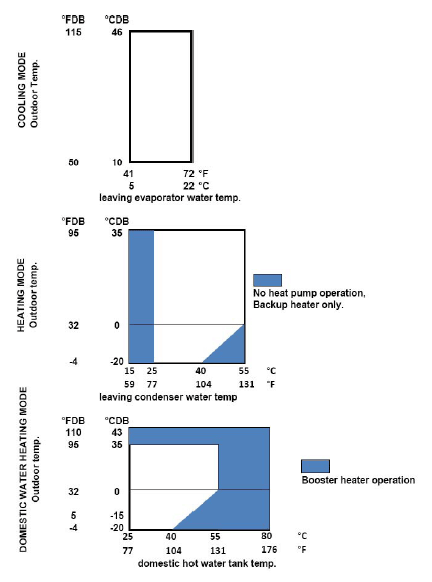- Where does it all start?
- Is the water function always included?
- Why do I need a Daikin hot water tank?
- Is the cooling function always included?
- Is it possible to combine Daikin Altherma with solar thermal tubes for domestic hot water heating?
- Can I upgrade a heating-only version of the hydrobox to a reversible hydrobox with cooling?
- What is the maximum water temperature from the heat pump?
- Can I connect radiators to the Daikin Altherma system even though the temperature is limited at 131ºF (55ºC)?
- Can fan coil units and floor heating be combined in the same system?
- If the maxium water temperature from the heat pump is 131ºF (55ºC), how can I reach a sufficient domestic water temperature?
- Can Daikin Altherma produce hot water in summer?
- What is the lower operation limit temperature for the Daikin Altherma system?
- What is a backup heater?
- Where is the backup heater placed?
- Will the backup heater always be switched on?
- Can Daikin Altherma be delivered without a backup heater?
- Is it possible to upgrade a low capacity backup heater to a larger capacity?
- What is the maximum water temperature out of the backup heater?
- Why is the water temperature limited to 131ºF (55ºC) even though I am using an electric backup heater?
- Will the backup heater and booster heater work simultaneously?
- What is the equilibrium point?
- How do I know where the equilibrium point is?
- What size fuses do I need for the outdoor unit power supply?
- Is there any wiring between the hydrobox and domestic tank?
- Are there separate power supplies for the electric heaters and the outdoor unit?
- Can I connect a mini-split outdoor unit to a hydrobox?
- What is the minimum water content of the system?
- Is there a need for an additional buffer tank to ensure that the water temperature does not drop during defrost?
- What is the factory warranty for Daikin Altherma?
- Is it possible to install the controller from the hydrobox remotely?
- Is it possible to install the hydrobox outside?
- What are the main operation functions on the controller?
- What is the schedule timer?
- Can I use separate room thermostats and programmable timers?
- What is the auto restart function?
- What happens to the clock when a power supply failure occurs?
- What happens to the schedule timer if the clock is reset?
- Which operational mode has priority?
- Why doesn’t the booster heater switch on immediately when there is a request for hot water?
- Will I still have sufficient capacity of hot water even if the heat pump or booster heater does not switch to hot water mode immediately?
- How does the compressor operate in hot water mode?
- What is a weather-dependent setpoint (outdoor reset)?
- What is the weather-dependent setpoint and when should it be used?
- What are the benefits of a weather dependent setpoint?
- What happens to the weather-dependent setpoint if the sun shines of the temperature sensor?
- Can the temperature sensor that is used to determine the weather-dependent setpont be mounted remotely from the outdoor unit?
- Can I use the weather-dependent setpoint if I install my outdoor unit in a garage that is warmer than the ambient outdoor temperature?
- What is an inverter compressor?
- Why is the dhw tank heat exchanger volume and surface area smaller than typical indirect water heaters?
- Why is there a minimum water volume of 5.3 gallons (20 liters) in the hydronic system?
- What are the dhw recovery characteristics?
- What material is used for the dhw tank?
- What material is used for the brazed plate heat exchanger located in the hydrobox?
- Can I cool the space by using under-floor cooling?
- Are there any refrigerant piping limitations?
- What considerations do I need to take when sizing the hydronic piping?
- Do I have to use a room thermostat connected to the hydrobox?
- Do I have to use a Daikin thermostat?
- Are there additional installation requirements?
- What is the difference between the equilibrium
balance point (thermal balance point) and economical balance point?
- Can I use antifreeze in split-type Daikin Altherma?
- Is antifreeze necessary for monobloc Daikin Altherma?
- Can I floor-mount the hydrobox?
- What if my hydronic circuit flow is greater than the maximum flow through Daikin Altherma?
- Do I need to treat the water in the hydronic system?
- What type expansion tank is supplied in the hydrobox?
- Can I integrate a Daikin Altherma system to an existing heating/hot water solution?
- Can both boilers operate simultaneously in a bi-valent application?
- When is the condensate kit required and what is its function?
- When is the EKRP1HBAAU digital i/o pcb kit required?
- What are the operation heating supply water temperatures for Altherma?
- What is the Daikin Altherma system operating range?
Where does it all start?
A heat pump only needs a heat source (the outside air), two heat exchangers (one to absorb and another one to release heat) and a relatively small amount of drive energy to keep the system going.
A heat pump extracts thermal energy from the environment. In the case of Daikin Altherma the source is the outside air. The pump extracts the energy at a certain temperature, increases that temperature, and then releases it into a medium which in Daikin Altherma system is the water running to your low temperature radiators, under floor heating system or fan coil units. Between those two media the heat is moved by means of a refrigerant (R-410A). Daikin Altherma is an air-to-water heat pump system, as displayed in the following image: 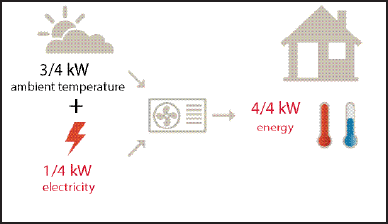
Is the water function always included?
Yes, but you need a Daikin hot water tank to make it operational. The Daikin DHW tank option also includes a 3-way diverting valve.
Why do I need a Daikin hot water tank?
The Daikin hot water tank contains specially designed and positioned heating elements and sensors that are critical to effective operation.
Is the cooling function always included?
No, the cooling function is an option available only on the reversible versions of the Hydrobox model numbers EKHBX054BA3VJU and EKHBX054BA6VJU.
Is it possible to combine Daikin Altherma with solar thermal tubes for domestic hot water heating?
Yes, Daikin offers an integrated solar connection kit. The Solar Kit model number: EKSOLHWAVJU. Digital I/O PCB model number: EKRP1HBAAU.
Can I upgrade a heating-only version of the hydrobox to a reversible hydrobox with cooling?
No. The reversible Hydrobox has extra insulation on the pipes because of condensation. There is also a software difference between the two models.
What is the maximum water temperature from the heat pump?
131ºF (55ºC).
Can I connect radiators to the Daikin Altherma system even though the temperature is limited at 131ºF (55ºC)?
Yes, Daikin Altherma can be connected to radiators. In many cases, old radiators that are sized for 158ºF (70ºC) are heavily oversized and can also be used with a water temperature of 131ºF (55ºC) or lower.
Can fan coil units and floor heating be combined in the same system?
Yes, but the leaving water temperature must then be adjusted to match the temperature requirement for the fan coil units. The temperature in the floor loops must be reduced to a suitable level by the use of a mixing valve or shunt connection. The heat pump capacity and COP will decrease with increasing water temperatures.
If the maxium water temperature from the heat pump is 131ºF (55ºC), how can I reach a sufficient domestic water temperature?
Inside the Daikin domestic hot water tank there is an electric booster heater (3kW) that raises the water temperature from 131ºF (55ºC) to a maximum of 176ºF (80ºC), though a typical storage tempeature of 122-131ºF (50-55ºC) is sufficient.
Can Daikin Altherma produce hot water in summer?
Yes, Daikin Altherma can run in hot water mode up to an ambient temperature of 95ºF (35ºC). The heating and cooling version alternate between hot water mode and cooling mode. At outside temperatures exceeding 95ºF (35ºC), hot water can still be produced using the booster heater, or through Solar if integrated to a solar thermal solution.
What is the lower operation limit temperature for the Daikin Altherma system?
The defined operation limit is -4ºF (-20ºC) but the heat pump does not switch OFF at a certain temperature because of a software block. At low ambient temperatures, the backup heater generates additional heating capacity.
What is a backup heater?
The backup heater provides supplementary space heating capacity in addition to the heat pump in severe weather conditions.
Where is the backup heater placed?
The backup heater is inside the hydrobox. All the circulating water passes through the heat exchanger and then through the backup heater
cylinder.
Will the backup heater always be switched on?
No, the backup heater will only switch ON if the heat pump cannot reach the leaving water setpoint temperature within a certain time period. When the setpont is reached, the backup heater switches OFF again.
Can Daikin Altherma be delivered without a backup heater?
No. The backup heater must be installed to ensure that the water temperature never drops below 59ºF (15ºC) during startup of the stystem or during defrost.
Is it possible to upgrade a low capacity backup heater to a larger capacity?
No. A larger capacity backup heater is not available, but 3kW and 6kW (2 stage) backup heaters are available.
What is the maximum water temperature out of the backup heater?
131ºF (55ºC).
Why is the water temperature limited to 131ºF (55ºC) even though I am using an electric backup heater?
The return water temperature to the heat pump is limited to 131ºF (55ºC). A return water temperature above this will activate safety devices and the compressor frequency will decrease.
Will the backup heater and booster heater work simultaneously?
The backup heater is never operational in heat pump hot-water mode. Both heaters can be operational if the backup heater is running and the booster heater ON temperature is reached, or if the outdoor unit breaks down and the backup heater has to cover the entire space heating load. The simultaneous operation of the backup heater and booster can be prevented by a field setting.
What is the equilibrium point?
It is the point at which the heat pump performance most closely matches the heating demand and no additional heat source is required. This is also known as the thermal balance point.
How do I know where the equilibrium point is?
The equilibrium point is not a fixed point. The backup heater switches ON if the heat pump cannot reach the setpoint water temperature within a certain time period independently of the ambient tempature, as long as the backup heat operation is not disabled by the field setting.
What size fuses do I need for the outdoor unit power supply?
Each Daikin Altherma outdoor unit requires a 30A fuse in both the split type (ERLQ) and monobloc type (EBLQ & EDLQ) units. Refer to the Installation Manual for instructions.
Is there any wiring between the hydrobox and domestic tank?
Yes. Refer to the Installation Manual.
Are there separate power supplies for the electric heaters and the outdoor unit?
Yes. Refer to the Installation Manual.
Can I connect a mini-split outdoor unit to a hydrobox?
No. The RA type mini-split condensing units are not configured to operate with a Hydrobox. The PCBs in thse condensing units are configured for DX operation only and do not incorporate the parameters for water heating and cooling.
What is the minimum water content of the system?
5.3 gallons (20 liters) is the minimum water volume for all systems. This volume excludes the volume of the heat emitters selected. 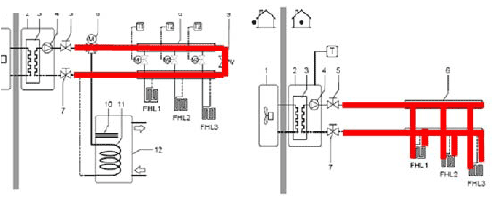
Is there a need for an additional buffer tank to ensure that the water temperature does not drop during defrost?
It is not necessarily required but the backup heater will provide the necessary heating capacity if the water temperature drops below 59ºF (15ºC). In specific applications where a buffer tank is requested, it can be implemented in the hydronic system.
What is the factory warranty for Daikin Altherma?
The North American Warranty is:
7 years for the compressor, 5 years for parts (including DHW tank and Hydrobox components), 1 year limited labor. Please refer to the official Daikin AC Warranty Terms and Conditions for detailed information.
Is it possible to install the controller from the hydrobox remotely?
Yes, up to 164 ft (50 m) with a specially provided cable. Contact Daikin AC for the right parts.
Is it possible to install the hydrobox outside?
No. The hydrobox installation location must be frost-free. Temperatures should range between 33ºF (1ºC) to 95ºF (35ºC).
The hydrobox is not agency certified for outdoor installation.
What are the main operation functions on the controller?
The controller has several levels, and many settings
are set by the installer during commissioning.
The main user settings are:
- ON/OFF
- Space heating operation
- Space cooling operation
- Water heating operation
- Silent mode operation
- Temperature setpoint adjustment
- Powerful water heating operation
- Schedule timer programming
What is the schedule timer?
The schedule timer allows the user to set the operation of the system according to a daily or weekly program.
- Switch ON/OFF the installation at a scheduled time, in combination with a setpoint temperature for a space heating/cooling program.
- Switch ON/OFF the installation at a scheduled time for a water heating program, booster heater program, or silent mode program.
Can I use separate room thermostats and programmable timers?
Yes, separate controls can be used to adjust room temperatures and will notify the Daikin Altherma system when the room requires heating/cooling. Daikin Altherma will then operate to deliver the set leaving water temperature.
What is the auto restart function?
The Auto Restart function reapplies the user interface settings when the power returns after a supply failure.
What happens to the clock when a power supply failure occurs?
A power failure exceeding one hour will reset the clock.
What happens to the schedule timer if the clock is reset?
The schedule timer will continue operation but the clock needs to be reset to reflect the actual time.
Which operational mode has priority?
The system works according to the greatest temperature difference between actual water temperature and setpoint. If Daikin Altherma is running in space heating, it will immediately switch to domestic hot water if the temperature difference in the tank is larger than the temperature difference for space heating. When the system is running in hot water mode, the setpoint must be reached before the system switches back to space heating mode.
Why doesn’t the booster heater switch on immediately when there is a request for hot water?
It is desirable to let the heat pump cover as much of the hot water production load as possible with high COP. The booster heater delay ensures that the booster heater is not used more than necessary.
Will I still have sufficient capacity of hot water even if the heat pump or booster heater does not switch to hot water mode immediately?
Yes. Daikin Altherma is not based on instant water heating like a gas boiler. The tank has a storage volume of 50 or 80 gallons (200 or 300 liters) of hot water that covers the load while the system switches to hot water mode.
How does the compressor operate in hot water mode?
The compressor runs at highest frequency.
What is a weather-dependent setpoint (outdoor reset)?
When the weather-dependent setpoint functionality is enabled, the setpoint for the leaving water temperature will be dependent upon the outside ambient temperature. At low outside ambient temperatures, the leaving water temperature increases to satisfy the increasing heating requirement of the building. At warmer temperatures, the leaving water temperature decreases to save energy.
What is the weather-dependent setpoint and when should it be used?
The weather dependent setpoint or sometimes called outdoor reset is when Daikin Altherma control senses outside temperature and readjust the heating system water to a minimum water temperature to satisfy the heat loss of the home. This accomplishes two major things: one it will save energy and second it creates more comfort by eliminating short cycling of Daikin Altherma at mild outdoor temperatures. During weather dependent operation, the user has the option to shift up or down the target water temperature by a maximum of 9°F (5°C). 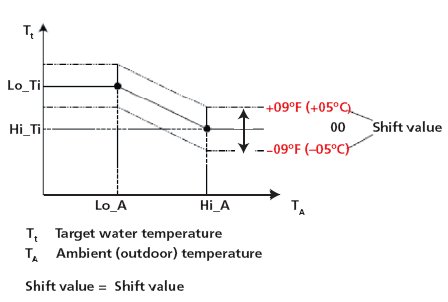
What are the benefits of a weather dependent setpoint?
The floating setpoint ensures that the heat emitter temperature is never higher than necessary and this leads to the highest possible comfort level. A heat pump requires more energy input the higher the water temperature, meaning that the floating setpoint also ensures the lowest possible energy consumption.
What happens to the weather-dependent setpoint if the sun shines of the temperature sensor?
The setpoint might deviate and give a lower water temperature than is actually needed. It is recommended to install some type of sun protection above the outdoor unit.
Can the temperature sensor that is used to determine the weather-dependent setpont be mounted remotely from the outdoor unit?
No. The sensor is calibrated to a certain resistance and changing the wire length impacts this calibration.
Can I use the weather-dependent setpoint if I install my outdoor unit in a garage that is warmer than the ambient outdoor temperature?
No, the floating setpoint is dependent on the temperature sensor in the outdoor unit. If the outdoor unit is installed in a warm place, a fixed setpoint temperature must be used.
What is an inverter compressor?
An inverter compressor gradually increases or decreases its capacity based on the duty needed to cool down or heat up the water.
Why is the dhw tank heat exchanger volume and surface area smaller than typical indirect water heaters?
The heat exchanger is designed to optimize heat transfer for both heat pump and solar operation and takes into account Daikin inverter compressor technology allowing higher heat pump capacities at lower outdoor ambient conditions. The DHW tank heat exchanger volume is 1.8 gal/6.8 l and surface area is 15.6 ft2/1.45 m2.
Why is there a minimum water volume of 5.3 gallons (20 liters) in the hydronic system?
The minimum water volume is to ensure complete defrost cycles and to eliminate short cycling of the outdoor unit. This allows the system to operate efficiently and reliable. Do not include the water volume from the hydrobox in the system minimum water volume.
What are the dhw recovery characteristics?
On average, 55 minutes without booster heater. See chart below for details (recovery times based on 80°F/44.5°C ?T): 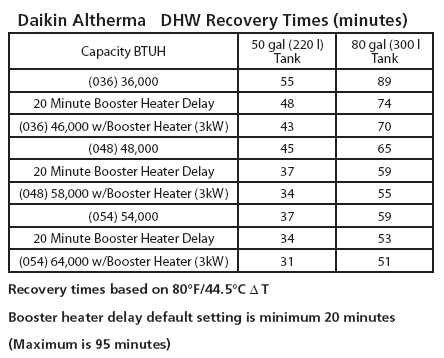
What material is used for the dhw tank?
DHW tank is stainless steel 316L. The DHW tank uses 1.57 inch (40mm) thick polyurethane foam insulation which keeps standby heat losses to a maximum of 0.5°F/0.3°C per hour.
What material is used for the brazed plate heat exchanger located in the hydrobox?
The braze plate heat exchanger is made of cupro-nickel material for efficient heat transfer and corrosion resistance.
Can I cool the space by using under-floor cooling?
Because cool air drops and the minimum temperature for under floor cooling is 64°F/18°C (to eliminate condensate from forming), cooling the slab or floor is not an effective or efficient way to cool the space. A fan coil unit is recommended and has to be supplied by the contractor. Radiant cooling is more of a refresh mode because it cools down the envelope of the structure and not individuals.
Are there any refrigerant piping limitations?
Yes, see following list: 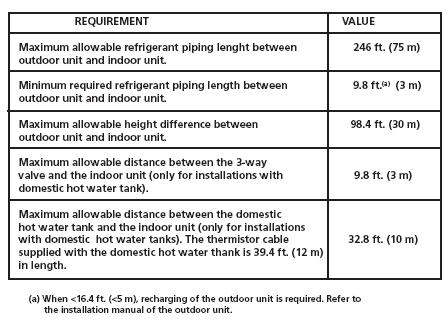
What considerations do I need to take when sizing the hydronic piping?
Select piping diameter in relation to required water flow and available ESP of the pump. See following example: 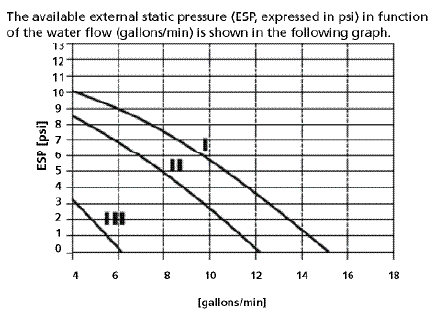
Minimum water flow through the hydrobox is 4.3 gpm; maximum is 15.3 gpm. (feet of head = psi x 2.31)
Do I have to use a room thermostat connected to the hydrobox?
Even though Daikin Altherma operates without an external thermostat, Daikin highly recommends this feature to be included. This will prevent excessive space heating and save energy since the system will stop operating when the room temperature is above the thermostat set point.
Do I have to use a Daikin thermostat?
It is also recommended to use a Daikin thermostat. The control logic of the Daikin thermostat matches Daikin Altherma for enhanced reliability. If a third party thermostat is used, it must be capable of setting the heating minimum run-time of six (6) minutes. Thermostats with minimal heating run times are not readily available and may be difficult to source.
Are there additional installation requirements?
It is sometimes necessary to install an oil trap per the following information: 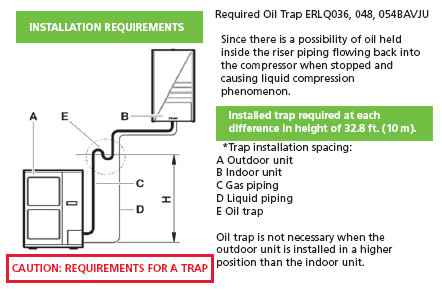
All refrigerant piping must be insulated along its full run using a minimum of 1/2” wall thickness insulation (e.g. Armaflex®). It is recommended to use a minimum 3/4” wall thickness insulation when running refrigerant piping through unconditioned spaces (attics, garages, crawl spaces and outdoors). (Refer to local codes). Note that: 1) Refrigerant gas and liquid piping should not be insulated together. 2) All joint areas must also be fully insulated.
What is the difference between the equilibrium
balance point (thermal balance point) and economical balance point?
The thermal balance point is the outside temperature
at which the amount of heating provided by Daikin Altherma equals the amount of heat lost from the house at setpoint. At this point, Daikin Altherma capacity matches the full heating needs of the house. The economic balance point is the outside temperature at which the cost of heat energy supplied by Daikin Altherma equals the cost of heat supplied by a supplementary heating system. In most cases the thermal balance point will be reached long before the economic balance point on a properly working Daikin Altherma system.
Can I use antifreeze in split-type Daikin Altherma?
It is not recommended to use antifreeze. Daikin Altherma has a freeze protection mode programmed in the hydrobox controller.
Is antifreeze necessary for monobloc Daikin Altherma?
Antifreeze can be used in Daikin Altherma Monobloc
applications where the site is not occupied or monitored, can be exposed to temperatures below freezing (32°F, 0°C) for long periods of time or could experience a high occurrence of power outages. Only propylene glycol formulated for hydronic heating can be used. Always remember that adding antifreeze will reduce the output capacity
of Daikin Altherma and may require larger expansion tank and circulators. To keep antifreeze mixtures at a minimum, Daikin recommends antifreeze mixtures for burst protection. Refer to installation instructions for propylene glycol mixtures and capacities corrections. Refer to local codes when using antifreeze.
Can I floor-mount the hydrobox?
No, the water, refrigerant and electrical connections are all at the bottom of the hydrobox. A minimum of 45.27 inches (1150mm) from the floor to the bottom of the hydro-box is required for access to these connections. This height requirement makes it difficult to store items on the top of the hydrobox, which could block the ventilation holes. The hydrobox is designed for wall-mounted installation only.
What if my hydronic circuit flow is greater than the maximum flow through Daikin Altherma?
A primary/secondary piping configuration will have to be used by incorporating closely spaced tees or a hydro separator. Maximum flow through the hydrobox is 15 gpm.
Do I need to treat the water in the hydronic system?
Typically no, most municipalities meet stringent water requirements. The water used in the Daikin Altherma hydronic system should have a pH of 7 to 8, hardness below 7 grains, and chlorine below 100 ppm. These requirements also apply if antifreeze is being used. Refer to local codes.
What type expansion tank is supplied in the hydrobox?
A bladder type of 2.6 gal (10 l) volume is provided in the hydrobox and comes precharged at 14.5 psi (1 bar) with dry nitrogen. Nitrogen has bigger molecules than air and is less likely to penetrate through the internal bladder in the expansion tank. It is highly recommended to use dry nitrogen when recharging or adding additional pressure to the expansion tank. Refer to installation instructions to calculate pre-pressure of expansion tank.
Can I integrate a Daikin Altherma system to an existing heating/hot water solution?
Yes, the Bi-Valent application is ideal for refurbishment/upgrade installations. See details in the following diagram: 
Can both boilers operate simultaneously in a bi-valent application?
No, only one heating solution (boiler) can operate at a time.
When is the condensate kit required and what is its function?
The condensate kit (EKHBDP) for the hydrobox is required for cooling applications. The function of the condensate kit is to insulate the water piping in the hydrobox to eliminate any water from dripping on and possibly damaging components in the hydrobox. It is in kit form to facilitate ease of hydrobox installation. The condensate kit is installed after all required water and refrigerant piping connection have been made to the hydrobox.
When is the EKRP1HBAAU digital i/o pcb kit required?
Primarily, this kit is required for solar thermal applications to set solar priority. It can also be used with the hydrobox and outdoor unit for remote alarm and operation status reporting via voltage free (dry) contacts.
What are the operation heating supply water temperatures for Altherma?
Typical values are:
Floor heating: 86° to 95°F / 30° to 35°C
Fan Coil Units: 86° to 113°F / 30° to 45°C
Low temperature radiators: 104° to 122°F / 40° to 50°C
What is the Daikin Altherma system operating range?
The operating range is displayed in the following figure:
